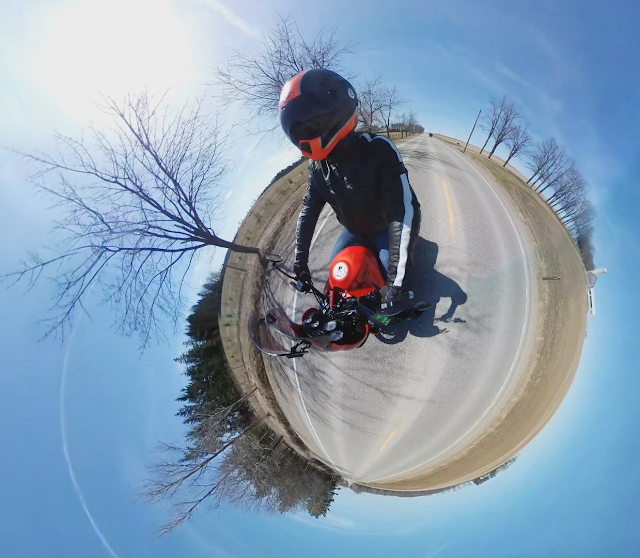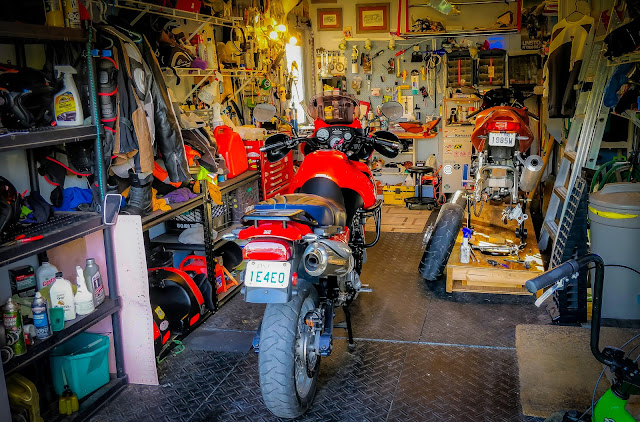The big five-oh is coming up so I got myself a present. I’ve always wanted a custom saddle and after seeing buddy Jeff’s new Sargent seat, I started looking into what’s available for the Tiger. Sargent doesn’t do anything for Tigers as old as mine, but Corbin does. Their site lets you customize your seat with material and stitching. The Tiger isn’t a shy and retiring sort of motorbike, so I wasn’t very conservative in my seat design.

Corbin lets you play with variations on their online customizing tool. I started off with basic black but quickly moved on from there. You can go full disco oligarch if you want, but I looked at the Tiger and worked out a design that pulls the colours already on the bike together on the seat. I took the most shocking part of the Tiger, the Lucifer Orange paint, and did the stitching in orange. Most of the mechanical bits are black, so I stayed with a black set but went with a gripper material rather than leather. The side panels I matched in navy blue with the blue on the swing arm. The goal was to design a seat that looks like it belongs on the bike, and I think it does that while not being dull.
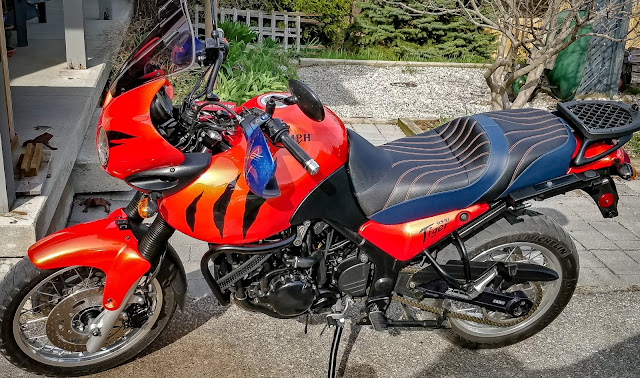 |
| It’s a pretty thing. |
The customization options offered by Corbin are exceptional. Less so was communication. I sent in the request online and got an email asking me to confirm the order. When I questioned the $120US delivery fee added on, I got no reply. The initial email also promised a follow up when the seat was going into production, but that didn’t happen either. What did happen was one day I got a bill for $94CAD on my front door when I got home from work. After driving over to the post office I got told there was a bill for taxes on the shipment, so that puts getting my Corbin to me at two hundred and fifty-five bucks (I could fly back from San Francisco where Corbin’s factory is for about the same price)… and I had to go pick it up.
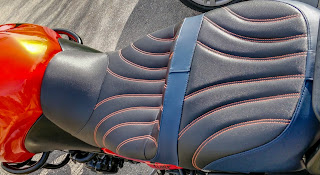
The seat itself is very nice on top. The underside looks a bit rough with loose bits and rough holes , but I guess no one will ever see it but me. It’s heavy duty leather so it’ll take a while to break in and will look better and better as it does.
Comfort wise, it feels very different from the curved stock saddle. The Corbin is much wider, making the ground further away. I can flat foot the Tiger on the stock saddle even when it’s in its highest position. The Corbin doesn’t adjust for height, but its width makes it feel much taller. The width was such a concern that I tried standing on the pegs to see if the seat interfered with my legs. I can feel the seat (not so with the curved and narrower stock seat), but it’s not pushing my knees away, so I can still stand on the pegs if necessary.
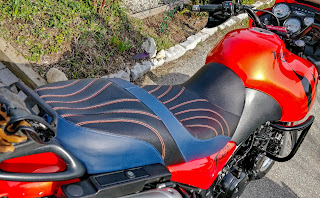
The seat’s back is so steep that it feels like a small backrest, which does wonders for support and comfort. My son is too big now to pillion with me (we exceed the bike’s carrying capacity), but if my wife ever comes for a ride, I think she’ll have a better view from a higher back seat.
The seat feels firm, but Corbin mention that as it breaks in it will conform to your butt specifically and soften. The width of it handles weight so well that I really don’t notice the hardness, and it’s supposed to fade away over time anyway. They suggest a 2000 mile break in period, which seems like a long one, but it is what it is.
 |
| It isn’t cheap, but the lifetime warranty takes care of any quality worries, and it seems a well put together thing, once I got it to attach to the bike. |
Installation wasn’t as easy as I’d have hoped. The Corbin is a single seat unit replacing a separate rider and passenger stock seat set. The stock rider seat has a couple of hoops on the frame that locate the front and a pin locking mechanism in the rear. The passenger seat has hooks on the front another pin locking mechanism at the back. The all-in-one Corbin seat doesn’t use the middle pin at all and wouldn’t locate and lock in the rear pin. Putting it on and off the big over and over trying to figure out why it wouldn’t lock ended up scratching the triangular side panels under the seat a bit, which was annoying.
I ended up removing the fuse box and taking out the middle locking pin as I was afraid it was preventing the seat from sitting down on the frame properly, but it ended up being the front metal bars that hook on the frame loops. They weren’t bent down enough to allow the seat to sit flat. After a bit of bending, I was finally able to get the seat to click into place.
I’m sitting higher on this new, firm Corbin seat, but it’s supposed to soften over time, so I think the height will ease a bit too. The ‘gripper’ fabric feels quality and tough and isn’t particularly grippy. I’m able to move around on it quite easily and I’m hoping it breathes a bit better than leather would. Hot seat in the summer is one of the things I’m hoping this solves.
I’d be happier with Corbin communicating (at all) and I’d have been a lot happier with the stratospheric shipping charge if it took care of border costs too. Paying the equivalent of airfare from San Francisco seems a bit excessive, especially when I get to deliver it to myself anyway. If you’re ever on holiday in northern California, pre-order your seat and then pick it up from the factory near San Jose and save yourself a pile of cash.
Overall? I’m happy with the seat. The upside is a quality seat that you can make uniquely yours for what I consider a reasonable amount of money for a bespoke item like this. When people are dropping twice this on slip on exhausts and helmets, the Corbin starts to look like good farkling value. It certainly makes a statement and as one of the key connection pieces between rider and motorbike, it’s a customization option that does a lot to make a bike feel special.

I just got back from a 232km romp across the Niagara Escarpment. Never once did I have to stop for numb bum. That’s never happened before, and it’s only supposed to get better?
Originally published from Blogger in May of 2019: http://bit.ly/2PP84mB
via IFTTT
Bike Magazine had an excerpt from Todd Blubaugh‘s Too Far Gone in the last issue. The excerpt was so moving that I just got up and purchased the book on Amazon.

















